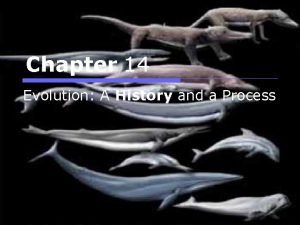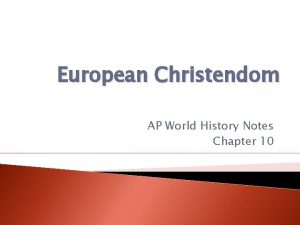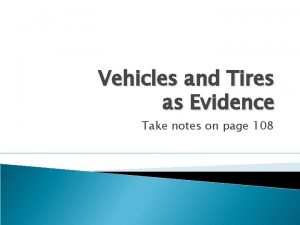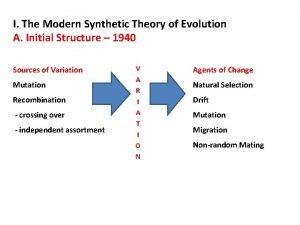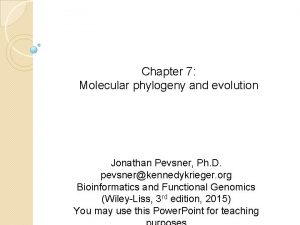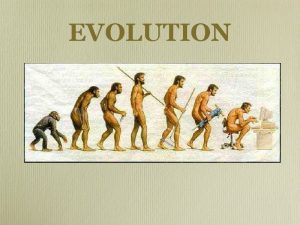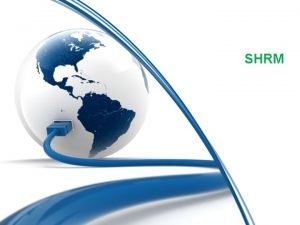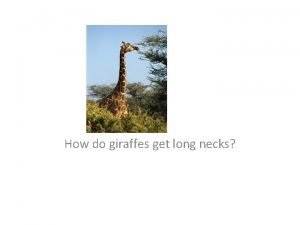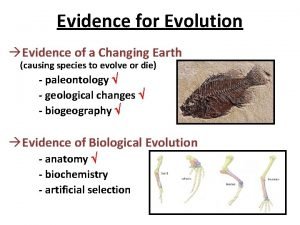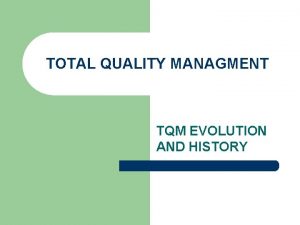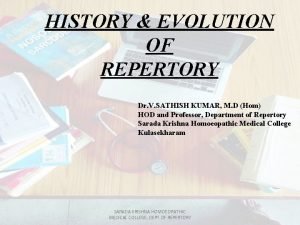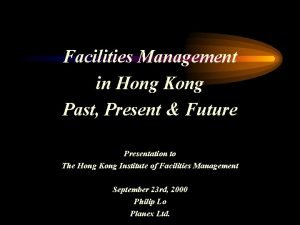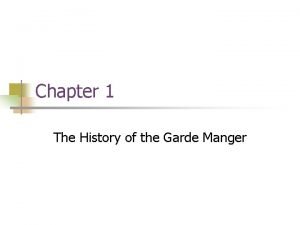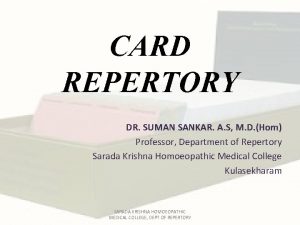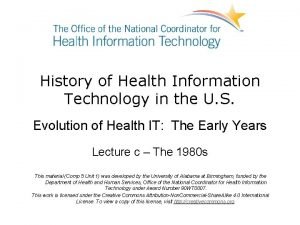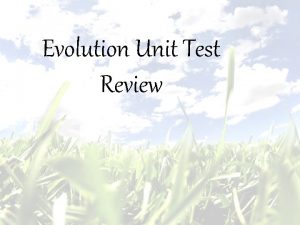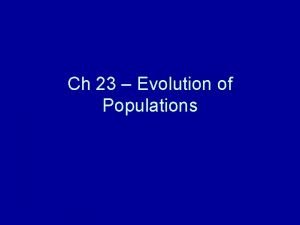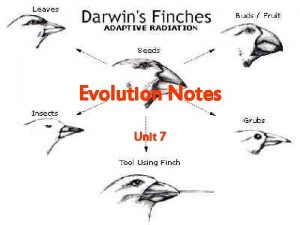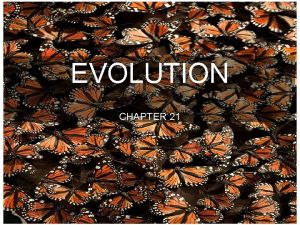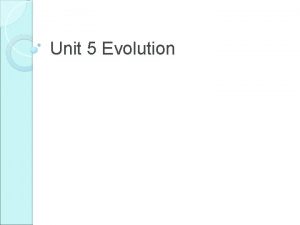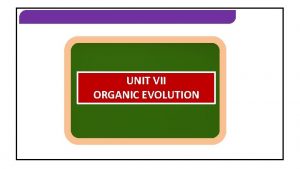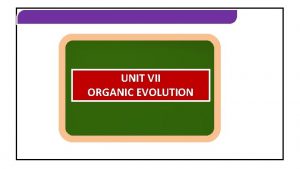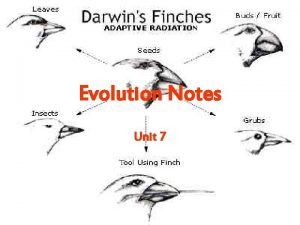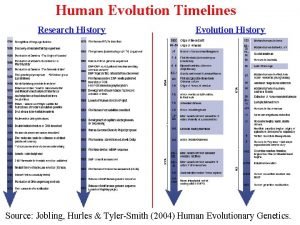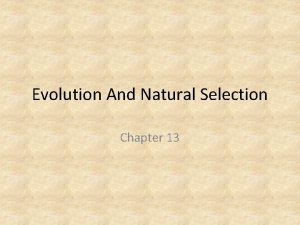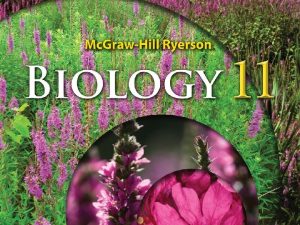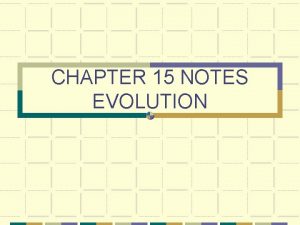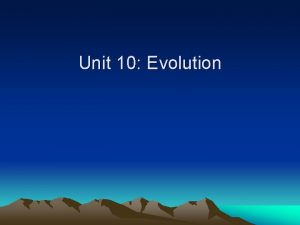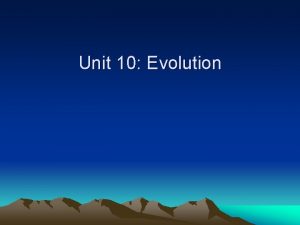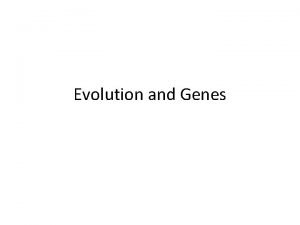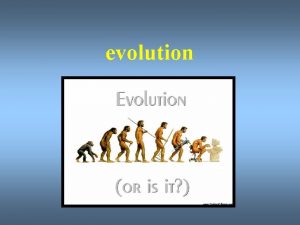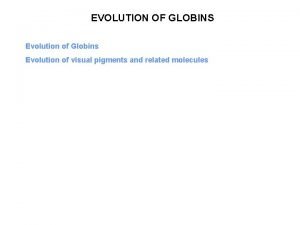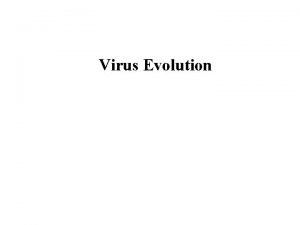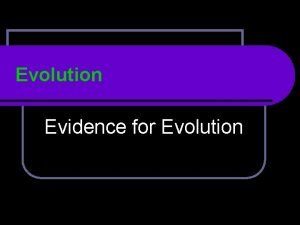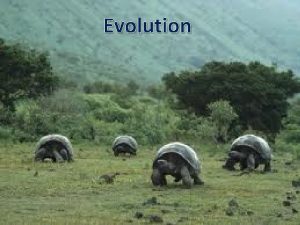Evolution Notes Unit 6 Chapter 14 The History




























































- Slides: 60

Evolution Notes Unit 6

Chapter 14 The History of Life 14. 1 Fossil Evidence of Change Land Environments § Earth formed about 4. 6 billion years ago.

Chapter 14 The History of Life 14. 1 Fossil Evidence of Change Clues in Rocks § A fossil is any preserved evidence of an organism. § Why are there gaps in the fossil record? Most organisms decompose before they have a chance to become fossilized.

Chapter 14 The History of Life 14. 1 Fossil Evidence of Change

Chapter 14 The History of Life 14. 1 Fossil Evidence of Change Fossil Formation § Nearly all fossils are formed in sedimentary rock.

Chapter 14 The History of Life 14. 1 Fossil Evidence of Change Dating fossils § Relative dating is a method used to determine the age of rocks by comparing them with those in other layers.

Chapter 14 The History of Life 14. 1 Fossil Evidence of Change Radiometric Dating § Uses the decay of radioactive isotopes to measure the age of a rock § Radioactive isotopes that can be used for radiometric dating are found only in igneous or metamorphic rocks.

Chapter 14 The History of Life 14. 1 Fossil Evidence of Change The Geologic Time Scale § The geological time scale is a model that expresses the major geological and biological events in Earth’s history.

Chapter 14 The History of Life 14. 1 Fossil Evidence of Change The Paleozoic Era § The ancestors of most major animal groups diversified in what scientists call the Cambrian explosion.

Chapter 14 The History of Life 14. 1 Fossil Evidence of Change § A mass extinction ended the Paleozoic era at the end of the Permian period. § Between 60 and 75 percent of the species alive went extinct.

Chapter 14 The History of Life 14. 1 Fossil Evidence of Change § Plate tectonics describes the movement of several large plates that make up the surface of Earth.

Terminology to know! • Hypothesis An “If…then” statement or proposal of an outcome of an experiment. (Ex. If I study, then I will pass the test. ) • Theory A hypothesis that has withstood extensive testing by a variety of methods, and in which a higher degree of certainty may be placed (Ex. Theory of Evolution) • Law Considered universal and invariable facts of the physical world (Ex. Law of Gravity)

Chapter 14 The History of Life 14. 2 The Origin of Life Origins: Early Ideas § Spontaneous generation is the idea that life arises from nonlife. § Francesco Redi, an Italian scientist, tested the idea that flies arose spontaneously from rotting meat.

Chapter 14 The History of Life 14. 2 The Origin of Life § The theory of biogenesis states that only living organisms can produce other living organisms. § Louis Pasteur designed an experiment to show that biogenesis was true even for microorganisms.

Chapter 14 The History of Life 14. 2 The Origin of Life Cellular Evolution § Scientists hypothesize that the first cells were prokaryotes. § These would compare to our modern day bacteria

Chapter 14 The History of Life 14. 2 The Origin of Life The Endosymbiotic Theory § Eukaryotic cells arose from communities formed by prokaryotic cells. § This theory explains the origin of chloroplasts and mitochondria.

Chapter 14 The History of Life 14. 2 The Origin of Life

Chapter 15 Evolution 15. 1 Darwin’s Theory of Natural Selection Darwin on the HMS Beagle § His job was to collect biological and geological specimens during the ship’s travel.

What can explain the large extent of biological diversity on earth? • Evolution – change over time – How life has changed over time

Chapter 15 Evolution 15. 1 Darwin’s Theory of Natural Selection The Galápagos Islands § Darwin began to collect mockingbirds, finches, & other animals on the 4 islands. § He noticed that the different islands seemed to have their own, slightly different varieties of animals.

The Galapagos Islands • West of South America • Group of islands each with different climates • Tortoises varied from island to island in neck length and shell shape • Finches varied in beak shape • Characteristics of plants and animals varied from island to island

Chapter 15 Evolution 15. 1 Darwin’s Theory of Natural Selection

Chapter 15 Evolution 15. 1 Darwin’s Theory of Natural Selection Darwin Continued His Studies § Darwin inferred that if humans could change species by artificial selection, then perhaps the same process could work in nature.

Chapter 15 Evolution 15. 1 Darwin’s Theory of Natural Selection § Individuals in a population show variations. § Variations can be inherited. § Organisms have more offspring than can survive with available resources. § Variations that increase reproductive success will have a greater chance of being passed on. § “Survival of the Fittest”

Chapter 15 Evolution 15. 1 Darwin’s Theory of Natural Selection The Origin of Species § Darwin published On the Origin of Species by Means of Natural Selection in 1859. § It is a means of explaining how evolution works.

Lamarck’s Theory • • • Pre-Darwin scientist Inheritance of acquired traits Organs used a lot could grow and change shape Organs not used would shrivel and disappear Theory was incorrect but significant because he was the first scientist to recognize that organisms had changed over time

Chapter 15 Evolution 15. 2 Evidence of Evolution Support for Evolution § The fossil record § Provide a record of species that lived long ago. § Show that ancient species share similarities with species that now live. Glyptodont Armadillo

Evolution Chapter 15 15. 2 Evidence of Evolution Support for Evolution § Geographic Distribution § The distribution of plants and animals that Darwin saw first suggested evolution to Darwin. Rabbit Mara

Chapter 15 Evolution 15. 2 Evidence of Evolution § Derived traits are newly evolved features, such as feathers, that do not appear in the fossils of common ancestors. § Ancestral traits are more primitive features, such as teeth and tails, that do appear in ancestral forms.

Homologous Structures § Anatomically similar structures inherited from a common ancestor

Chapter 15 Evolution Analogous Structures § Same function but different structure § NOT inherited from common ancestor.

Chapter 15 Evolution 15. 2 Evidence of Evolution Vestigial Structures § Structures that are the reduced forms of functional structures in other organisms. § Evolutionary theory predicts that features of ancestors that no longer have a function for that species will become smaller over time until they are lost.

Chapter 15 Evolution 15. 2 Evidence of Evolution § Comparisons of the similarities in organisms are seen in comparative anatomy and in the fossil record. § Organisms with closely related morphological features have more closely related molecular features.

More Terms • Fitness – ability of an individual to survive and reproduce in a specific environment • Adaptation – inherited characteristic that increases an organism’s chance of survival –Can be physical traits as well as behavioral traits

Chapter 15 Evolution 15. 2 Evidence of Evolution Camouflage § Allows organisms to become almost invisible to predators Leafy sea dragon

Chapter 15 Evolution 15. 2 Evidence of Evolution Mimicry § One species evolves to resemble another species. Western coral snake California kingsnake

Chapter 15 Evolution 15. 3 Shaping Evolutionary Theory Natural Selection § Acts to select the individuals that are best adapted for survival and reproduction

Chapter 15 Evolution 15. 3 Shaping Evolutionary Theory § Stabilizing selection operates to eliminate extreme expressions of a trait when the average expression leads to higher fitness. § Ex. Siberian Husky

Chapter 15 Evolution 15. 3 Shaping Evolutionary Theory § Directional selection makes an organism more fit. § Favors the extremes § Ex. Greyhound Dog

Chapter 15 Evolution 15. 3 Shaping Evolutionary Theory § Disruptive selection is a process that splits a population into two groups. § Ex. Black, White, & Gray Rabbits

Chapter 15 Evolution 15. 3 Shaping Evolutionary Theory Mechanisms of Evolution § Population genetics § Hardy-Weinberg principle states that when allelic frequencies remain constant, a population is in genetic equilibrium.

Chapter 15 Evolution 15. 3 Shaping Evolutionary Theory Write these down & know these!

Chapter 15 Evolution 15. 3 Shaping Evolutionary Theory Genetic Drift § A change in the allelic frequencies in a population that is due to chance and random mating § In smaller populations, the effects of genetic drift become more pronounced, and the chance of losing an allele becomes greater. § Marble Example

Chapter 15 Evolution 15. 3 Shaping Evolutionary Theory Nonrandom Mating § Promotes inbreeding & could lead to a change in allelic proportions favoring individuals that are homozygous for particular traits

Chapter 15 Evolution 15. 3 Shaping Evolutionary Theory Founder Effect § The loss of genetic variation that occurs when a new population is established by a very small number of individuals from a larger population Island 1 Island 2 Mainland Island 3

Evolution 15. 3 Shaping Evolutionary Theory Bottleneck § a significant percentage of a population or species is killed or otherwise prevented from reproducing and can rebound later § Often caused by a natural disaster

What is a gene pool? • Gene pool – combined genetic info of all members of a population – Contains two of more alleles (genes) for the same trait – Allele frequency – number of times an allele occurs in a gene pool compared to the number of times another allele occurs (expressed in percents)

Relative Frequencies of Alleles Section 16 -1 allele for brown fur allele for black fur Sample Population 48% heterozygous black 36% homozygous brown Frequency of Alleles 16% homozygous black

Gene Flow • Genes entering or leaving a population • AKA. Migration – Emigration Genes LEAVING a population – Immigration INCOMING genes in a population

What are sources for genetic variation? • Mutations – random change in the DNA, may cause evolution in future populations • Genetic shuffling – occurs in meiosis when gametes are formed

Chapter 15 Evolution 15. 3 Shaping Evolutionary Theory § Sexual selection operates in populations where males and females differ significantly in appearance.

Chapter 15 Evolution 15. 3 Shaping Evolutionary Theory § Prezygotic isolation prevents reproduction by making fertilization unlikely. • In behavioral isolation, patterns of courtship may be different. • In temporal isolation, different groups may not be reproductively mature at the same season, or month, or year. • In ecological isolation, not in the same habitat where they are likely to meet. Eastern meadowlark and Western meadowlark

Chapter 15 Evolution 15. 3 Shaping Evolutionary Theory § Postzygotic isolation occurs when fertilization has occurred but a hybrid offspring cannot develop or reproduce. § Prevents offspring survival or reproduction Liger

Chapter 15 Evolution 15. 3 Shaping Evolutionary Theory Allopatric Speciation § A physical barrier divides one population into two or more populations. Abert squirrel Kaibab squirrel

Chapter 15 Evolution 15. 3 Shaping Evolutionary Theory Sympatric Speciation § A species evolves into a new species without a physical barrier. § The ancestor species and the new species live side by side during the speciation process.

Chapter 15 Evolution 15. 3 Shaping Evolutionary Theory Adaptive Radiation § Can occur in a relatively short time when one species gives rise to many different species in response to the creation of new habitat or some other ecological opportunity

Chapter 15 Evolution 15. 3 Shaping Evolutionary Theory Coevolution § The relationship between two species might be so close that the evolution of one species affects the evolution of the other species. § Mutualism § Coevolutionary arms race

Chapter 15 Evolution 15. 3 Shaping Evolutionary Theory Convergent Evolution § Unrelated species evolve similar traits even though they live in different parts of the world.

Chapter 15 Evolution 15. 3 Shaping Evolutionary Theory Rate of Speciation § Evolution proceeds in small, gradual steps according to a theory called gradualism. § Punctuated equilibrium explains rapid spurts of genetic change causing species to diverge quickly.

Chapter 15 Evolution 15. 3 Shaping Evolutionary Theory
 Chapter 14 evolution a history and a process
Chapter 14 evolution a history and a process Mongols chapter 13
Mongols chapter 13 Chapter 11 ap world history notes
Chapter 11 ap world history notes Chapter 20 ap world history notes
Chapter 20 ap world history notes Western christendom ap world history
Western christendom ap world history Chapter 15 ap world history
Chapter 15 ap world history Evidence for evolution doodle notes
Evidence for evolution doodle notes Modern synthetic theory of evolution notes
Modern synthetic theory of evolution notes Neutral theory of molecular evolution notes
Neutral theory of molecular evolution notes Lamarck theory of evolution notes
Lamarck theory of evolution notes Chapter 5 evolution and community ecology
Chapter 5 evolution and community ecology Evolution of shrm notes
Evolution of shrm notes Modern theory of evolution
Modern theory of evolution Lamarck's theory
Lamarck's theory Unit 10, unit 10 review tests, unit 10 general test
Unit 10, unit 10 review tests, unit 10 general test Total quality management history
Total quality management history History and evolution of repertory
History and evolution of repertory Future of facilities management
Future of facilities management Garde manger history
Garde manger history Father of card repertory
Father of card repertory Doctrine of analogy in repertory
Doctrine of analogy in repertory History and evolution of health information technology
History and evolution of health information technology Conversion notes brutes en notes standard wisc 5
Conversion notes brutes en notes standard wisc 5 Evolution unit test
Evolution unit test Unit 10 evolution test answers
Unit 10 evolution test answers Smallest unit of evolution
Smallest unit of evolution Hát kết hợp bộ gõ cơ thể
Hát kết hợp bộ gõ cơ thể Bổ thể
Bổ thể Tỉ lệ cơ thể trẻ em
Tỉ lệ cơ thể trẻ em Gấu đi như thế nào
Gấu đi như thế nào Chụp phim tư thế worms-breton
Chụp phim tư thế worms-breton Chúa sống lại
Chúa sống lại Môn thể thao bắt đầu bằng chữ f
Môn thể thao bắt đầu bằng chữ f Thế nào là hệ số cao nhất
Thế nào là hệ số cao nhất Các châu lục và đại dương trên thế giới
Các châu lục và đại dương trên thế giới Công của trọng lực
Công của trọng lực Trời xanh đây là của chúng ta thể thơ
Trời xanh đây là của chúng ta thể thơ Cách giải mật thư tọa độ
Cách giải mật thư tọa độ Phép trừ bù
Phép trừ bù Phản ứng thế ankan
Phản ứng thế ankan Các châu lục và đại dương trên thế giới
Các châu lục và đại dương trên thế giới Thơ thất ngôn tứ tuyệt đường luật
Thơ thất ngôn tứ tuyệt đường luật Quá trình desamine hóa có thể tạo ra
Quá trình desamine hóa có thể tạo ra Một số thể thơ truyền thống
Một số thể thơ truyền thống Cái miệng bé xinh thế chỉ nói điều hay thôi
Cái miệng bé xinh thế chỉ nói điều hay thôi Vẽ hình chiếu vuông góc của vật thể sau
Vẽ hình chiếu vuông góc của vật thể sau Nguyên nhân của sự mỏi cơ sinh 8
Nguyên nhân của sự mỏi cơ sinh 8 đặc điểm cơ thể của người tối cổ
đặc điểm cơ thể của người tối cổ Giọng cùng tên là
Giọng cùng tên là Vẽ hình chiếu đứng bằng cạnh của vật thể
Vẽ hình chiếu đứng bằng cạnh của vật thể Fecboak
Fecboak Thẻ vin
Thẻ vin đại từ thay thế
đại từ thay thế điện thế nghỉ
điện thế nghỉ Tư thế ngồi viết
Tư thế ngồi viết Diễn thế sinh thái là
Diễn thế sinh thái là Dạng đột biến một nhiễm là
Dạng đột biến một nhiễm là Thế nào là số nguyên tố
Thế nào là số nguyên tố Tư thế ngồi viết
Tư thế ngồi viết Lời thề hippocrates
Lời thề hippocrates
